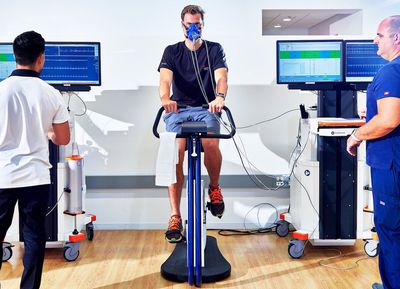Ahead of Apple's now-confirmed September 12 media event, during which it's believed to announce the newest versions of the Apple Watch, iPhone, and Apple TV, Men's Health was invited to visit Apple's secret exercise lab where activity data on its wearable device is collected. Apple invited the media to its Apple Watch lab before the launch of the original Apple Watch in early 2015, and now Jay Blahnik, Apple’s director of fitness and health technologies, said that the lab has "collected more data on activity and exercise than any other human performance study in history."
Although Apple revealed the lab in 2015, Blahnik mentioned that work in the department has been ongoing for the past five years. The lab enlists Apple employees to perform various exercises while hooked up to metabolic carts, ECG machines, and $40,000 masks that analyze calories burned, oxygen consumption, and more. Around 40 employees work out in the lab at one time, all monitored by 13 exercise physiologists and 29 nurses and medics.

The lab includes a studio for group fitness programs, one room with an endless pool to measure the new waterproof abilities of Apple Watch, and another trio of rooms mimicking intense temperature conditions, which Apple calls "Higher, Faster, and Stronger." In 2015, Blahnik said the lab had collected over 18,000 hours of fitness data on over 10,000 workout sessions, and now those numbers have jumped to 66,000 hours and 33,000 sessions.
“Our lab has collected more data on activity and exercise than any other human performance study in history,” says Jay Blahnik, Apple’s director of fitness for health technologies, in a rare interview. “Over the past five years, we’ve logged 33,000 sessions with over 66,000 hours of data, involving more than 10,000 unique participants.” A typical clinical trial enrolls fewer than a hundred participants.
Blahnik commented on the "game-ifying" of fitness challenges that Apple has introduced with Apple Watch and Activity Sharing, where users can follow their friends' calorie, workout, and standing data throughout the day, and encourage or taunt one another in the process. He said that Apple's goal was to make it easier for people to feel part of a workout community, even when they aren't nearby one another, providing another "fun way to stay in touch" with friends on Apple Watch.

With watchOS 4, Apple Watch devices will also be gaining the ability to provide more nuanced insight into each user's daily goals, and give them little prompts towards the end of the day regarding how close they might be to closing an Activity Ring. The company has put together corporate fitness challenges around all of these activity features in the past, which Blahnik said has catalyzed healthy lifestyles that many employees continue to maintain.
This year Apple held its own global monthlong corporate health challenge, with tens of thousands of participants in teams of four, using the Lose It! Challenges app. Closing the watches’ tricolored rings was part of the game. It seeded health streaks that many at the company are still maintaining. “You noticed it on campus and in our retail stores,” says Blahnik. “Everyone was more active and engaged in their health. There was a lot of back and forth to encourage and motivate your team members to close their rings.”
The third-generation Apple Watch -- expected to be called "Series 3" -- is rumored to include cellular connectivity, further untethering Apple Watch from iPhone and allowing users to send messages and stream Apple Music solely on the wearable device. The Apple Watch Series 3 was originally rumored to see a major design overhaul, but more recent reports have said that added LTE connectivity will be the third generation's big selling point and a form factor change will be held for a future device.























